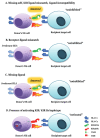Natural Killer (NK) Cell Alloreactivity in Haploidentical Stem Cell Transplantation
- PMID: 40710344
- PMCID: PMC12293795
- DOI: 10.3390/cells14141091
Natural Killer (NK) Cell Alloreactivity in Haploidentical Stem Cell Transplantation
Abstract
This paper conducts a literature review on the role of natural killer cells in haploidentical hematopoietic stem cell transplantation. Theoretical concepts related to KIR genes are introduced regarding their structure, nomenclature, genetic organization, polymorphism, and inheritance pattern, types of KIR proteins and receptors, HLA ligands for KIR receptors, and the definition of different NK alloreactivity prediction models for the donor of haploidentical hematopoietic stem cell transplantation and the recipient. These models include the following and consider incompatibility: ligand-ligand, receptor-ligand, gene-gene, and KIR haplotype models or the KIR-B donor group. These models consider the presence or absence of specific ligands or receptors and/or KIR genes in the donor and recipient to predict alloreactivity. Determining the best model for predicting KIR alloreactivity and its significance in donor selection algorithms for haploidentical transplantation is still under investigation.
Keywords: alloreactivity; haploidentical hematopoietic stem cell transplantation; natural killer.
Conflict of interest statement
The authors declare no conflict of interest.
Figures





Similar articles
-
NK Alloreactivity Evaluation According to KIR-HLA Interaction Models Influences the Outcome of Haploidentical Haematopoietic Stem-Cell Transplantation Based on Post-Transplant Cyclophosphamide.HLA. 2025 Aug;106(2):e70340. doi: 10.1111/tan.70340. HLA. 2025. PMID: 40747880
-
Improved survival with inhibitory killer immunoglobulin receptor (KIR) gene mismatches and KIR haplotype B donors after nonmyeloablative, HLA-haploidentical bone marrow transplantation.Biol Blood Marrow Transplant. 2010 Apr;16(4):533-42. doi: 10.1016/j.bbmt.2009.11.022. Epub 2009 Dec 2. Biol Blood Marrow Transplant. 2010. PMID: 19961944 Free PMC article. Clinical Trial.
-
Impact of KIR/HLA Incompatibilities on NK Cell Reconstitution and Clinical Outcome after T Cell-Replete Haploidentical Hematopoietic Stem Cell Transplantation with Posttransplant Cyclophosphamide.J Immunol. 2019 Apr 1;202(7):2141-2152. doi: 10.4049/jimmunol.1801489. Epub 2019 Feb 20. J Immunol. 2019. PMID: 30787107
-
An overview of methods required to evaluate donor NK cell alloreactivity for haploidentical haemopoietic stem cell transplantation.Methods Mol Biol. 2012;882:469-76. doi: 10.1007/978-1-61779-842-9_26. Methods Mol Biol. 2012. PMID: 22665250 Review.
-
The Influence of KIR Gene Polymorphisms and KIR-ligand Binding on Outcomes in Hematologic Malignancies following Haploidentical Stem Cell Transplantation: A Comprehensive Review.Curr Cancer Drug Targets. 2023;23(11):868-878. doi: 10.2174/1568009623666230523155808. Curr Cancer Drug Targets. 2023. PMID: 37226789 Review.
References
-
- Cooley S., Weisdorf D.J., Guethlein L.A., Klein J.P., Wang T., Le C.T., Marsh S.G.E., Geraghty D., Spellman S., Haagenson M.D., et al. Donor selection for natural killer cell receptor genes leads to superior survival after unrelated transplantation for acute myelogenous leukemia. Blood. 2010;116:2411–2419. doi: 10.1182/blood-2010-05-283051. - DOI - PMC - PubMed
Publication types
MeSH terms
Substances
LinkOut - more resources
Full Text Sources
Research Materials

